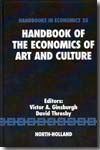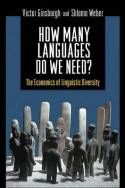Handbook of the economics of art and culture
- ISBN: 9780444508706
- Editorial: North Holland
- Fecha de la edición: 2006
- Lugar de la edición: Amsterdam. Países Bajos
- Colección: Handbooks in economics
- Encuadernación: Cartoné
- Medidas: 24 cm
- Nº Pág.: 1319
- Idiomas: Inglés

Over the last 30 or 40 years, a substantial literature has grown up in which the tools of economic theory and analysis have been applied to problems in the arts and culture. Economists who have surveyed the field generally locate the origins of contemporary cultural economics as being in 1966, the year of publication of the first major work in modern times dedicated specifically to the economics of the arts. It was a book by Baumol and Bowen which showed that economic analysis could illuminate the supply of and demand for artistic services, the contribution of the arts sector to the economy, and the role of public policy. Following the appearance of the Baumol and Bowen work, interest in the economics of the arts grew steadily, embracing areas such as demand for the arts, the economic functions of artists, the role of the non-profit sector, and other areas. Cultural economics also expanded to include the cultural or entertainment industries (the media, movies, the publishing industry, popular music), as well as heritage and museum management, property right questions (in particular copyright) and the role of new communication technologies such as the internet. The field is therefore located at the crossroads of several disciplines: economics and management, but also art history, art philosophy, sociology and law. The Handbook is placed firmly in economics, but it also builds bridges across these various disciplines and will thus be of interest to researchers in all these different fields, as well as to those who are engaged in cultural policy issues and the role of culture in the development of our societies. It presents an overview of the history of art markets; addresses the value of art and consumer behavior toward acquiring art; and examines the effect of art on economies of developed and developing countries around the world.
Eds. Victor A. Ginsburgh, David Throsby








